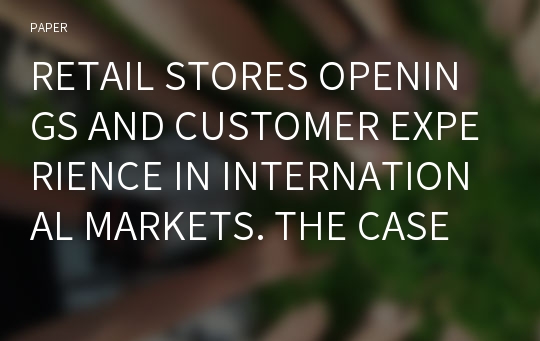RETAIL STORES OPENINGS AND CUSTOMER EXPERIENCE IN INTERNATIONAL MARKETS. THE CASE OF ITALIAN LUXURY MANUFACTURING COMPANIES
* 본 문서는 배포용으로 복사 및 편집이 불가합니다.
서지정보
ㆍ발행기관 : 글로벌지식마케팅경영학회(GFMC)
ㆍ수록지정보 : GFMC Session1
ㆍ저자명 : Simone Guercini, Andrea Runfola
ㆍ저자명 : Simone Guercini, Andrea Runfola
영어 초록
IntroductionThis article analyzes retail store openings of luxury fashion brands in international markets. Our aim is to point out the relevance of this market entry strategy as well as to highlight the main destination markets and different trends over the 2004-2013 period.
More precisely, this article analyzes the role of the retail direct channel as a means to manage relationships with consumers in international markets. The choice to develop retail operations in international markets is considered in this article as one of the key strategies implemented by luxury manufacturing companies. However, it seems to have received minor attention in the academic literature dealing with internationalization (Guercini and Runfola, 2014). Consequently, the main aim of this article is to propose empirical evidence to support the widespread use of this strategy by luxury firms, proposing the analysis of an original database built on the retail store operations of a sample of Italian fashion luxury companies over the period 2004-2013.
The retail marketing strategy is a peculiar strategy within the luxury marketing strategies. As stated by Kapferer and Bastien (2012), in fact, through retail store openings (and distribution in general), luxury companies may implement and take advantage from what has been defined by the authors the “watchword of luxury brand management” (p. 233) namely “experience”. In fact, the literature in the field of luxury retailing has pointed out the role of the point of sale from a consumer point of view to experience the value of a company. The discussion on the consumer perspective is increasing in the literature as testified by various contributions aimed at analyzing and discussing how and what kind of experiences could be transferred by the opening of retail stores and in what terms the luxury retail strategy differs from other retail marketing strategies (Dion and Arnould, 2011).
The opening of retail stores from luxury companies has been considered within the stream of research on the internationalization of the company. It has been pointed out that companies with luxury positioning can differentiate their offering with respect to mass market retailers and open retail stores even in culturally distant markets (Hutchinson et al. 2009). These openings, however, are considered more as ways of promoting the brand, rather than a structural international retail development (Moore et al., 2010). In fact, it has been noticed that luxury griffes open retail stores quite exclusively in primary locations (Hutchinson et al. 2009) and that most of the internationalization literature on retail stores openings by luxury firms is referred to the opening of flagship stores (Moore et al., 2010), a specific retail store format that from its nature, is mostly related to brand promotion than to an effective and stable retail development. In fact, retailing as international market entry strategy implies significant investment both in economic and cognitive terms (Mattila el al., 2002; Guercini and Runfola, 2010). The study of retail stores opening as an entry strategy in international markets remains an understudied field of study in the academic literature, as evidenced for example by Ilonen et al. (2011) in their study on the importance of branded retail in manufacturers' international strategy. Moreover, the authors point out that among other things, this remains a topic of interest but not yet analyzed in the case of the fashion industry.
Following this reasoning, our article aims to answer to the subsequent research questions: RQ1 - What is the evolution over time of the distribution investments of luxury fashion manufacturing companies? RQ2 - Is there a difference between emerging markets and advanced markets for luxury retail store openings? RQ3 - What is the role of metropolitan areas and how does this evolve over time?
Methodology and discussion
We investigate these research questions in the case of Italian luxury manufacturing companies. In order to study the expansion of Italian luxury companies, we have exploited the information contained in the database that we have created expressly for the purposes of this research. The database has been compiled by examining any news contained in two specialized and highly recognized national fashion-sector publications - Fashion and Pambianco Week - regarding the opening of retail outlets in foreign countries by Italian luxury firms in the decade 2004-2013. For the purpose of this research we have considered as luxury brands those brands that are members of Altagamma, a association whose members are Italian companies that operate at the highest end of the market, and those brands that are recognized globally and by academics and empirical press as luxury brands, although not being members of Altagamma. The above process has identified 594 sales points opened by 39 Italian brands in 62 countries over the period 2004-2013. The top 10 brands for number of store openings over this period are the followings: Prada (64), Salvatore Ferragamo (59), Miu Miu (51), Ermenegildo Zegna (31), Valentino (29), Armani (26), Versace (26), Gianfranco Ferrè (25), Brioni (22), Etro (22).
Hereafter we try to describe some preliminary findings regarding the three research questions advanced previously.
RQ1 – What is the evolution over time of the distribution investments of luxury fashion manufacturing companies?
Our analysis seems to show an evolution in this growth strategy over the period 2004-2013. In fact, if during the period 2004-2008 our analysis shows the opening of 261 single-brand outlets by the enterprises of our sample, during the period 2009-2013 the number of operations became 333 stores. This seems to highlight how, even in a period of international crisis, the retail strategy for luxury companies remained fundamental for growing abroad. The year 2008 is the year with the maximum number of stores opened by our companies (95 stores, roughly 16% of the total 594 stores opened), while the year 2004 is the one with the minimum number of stores opened, only 35 stores (roughly 6%). Moreover, each year from 2009-2011 accounts for over 70 stores.
RQ2- Is there a difference between emerging markets and advanced markets for luxury retail store openings?
In order to distinguish between “mature”, developed countries and “emerging” ones, we considered the first 24 countries that joined firstly the OCSE as “mature”, while all the remaining countries have been considered “emerging”. Our analysis reveals during the period analyzed a growing incidence by emerging markets compared to mature markets, given that emerging markets account for 60.9% of the openings. Moreover, in each year analyzed emerging markets overcome advanced markets for number of stores opened. However, traditional mature markets for Italian luxury (such as USA or Japan) as well as new emerging markets (such as China and Russia) are within the top destinations all over the period. If we consider only the first three markets for number of retail operations we may note some differences between the two sub-periods. In fact, during the period 2004-2008 the first three markets listed for decreasing number of operations were the USA (45 retail stores opened, 17,2% of the total number of stores), China (29 stores, 11,1% of the total) and India (19 stores, 7,3% of the total). During the period 2009-2013, China increased the number of operations, becoming the leading market with 74 stores, representing 22,2% over the total, followed by the USA (46 stores, 13,2% of the total) and United Arab Emirates (15 stores, 4,5%). The rising of China in the second period, is associated with an increasing importance of other emerging markets such as Brazil and South Korea, that in the previous period were not within the top international destinations. We should however stress that other mature markets, such as France and Japan still have key roles for Italian luxury companies.
RQ3 – What is the role of metropolitan areas and how does this evolve over time?
Our analysis shows that the major cities world-wide are present in our database. In total the companies in our sample have opened stores in 163 cities. Over the period 2004-2013 the top 10 cities listed for decreasing number of stores are the following: Shanghai (30), Hong Kong (28), New York (25), Moscow (24), Tokyo (22), Paris (21), Dubai (20), London (20), Los Angeles (20), Beijing (20). However, as evidenced by the data, while in the period 2004-2008, the total number of cities targeted by the companies were 83, in the following period 2009-2013 the number cities targeted became 127. This data seems to highlight how, over time, the presence of luxury firms is not only concentrated in the top cities around the world neither only in luxury streets, but affects a larger number of cities and locations. Take for example the case of the new rising Chinese cities of the II, III and IV tiers.
To conclude, our research points out how retail strategy implemented by luxury manufacturing companies is one of the driving strategy for relating the company with consumers in international markets. This strategy seems to represent a relevant and widespread used strategy to enter in foreign market and to develop the brand further.
Some considerations are due on the limitations inherent in the present study, which can also furnish some useful indications as to future work. The empirical evidence reported here is based on secondary research in market publications. Aside from collecting further, more up-to-date information, future research should be addressed to performing a number of enterprise case studies in order to acquire a better understanding of the phenomena at play through contacts with luxury enterprise managers with whom to share the main aspects involved in establishing sales networks in foreign countries. Moreover, the considerations advanced are based on empirical evidence drawn solely from study of the Italian luxury fashion industry. In this sense, future research should aim to check if any differences exist in retail store openings between the Italian fashion system and the luxury fashion industries of other economically mature nations (e.g., France, the UK, Japan or the USA).
Although, our empirical analysis has some limitations, it seems to confirm that the retail market strategy is a key strategy to relate with consumers in international markets and to let them “experience” the brand. For manufacturing companies in the luxury field this strategy should not be considered only in terms of promotion, as typically associated with the opening of flagship stores abroad. Rather, it represents an effective retail strategy with important implications from a managerial point of view. Considering this latter point, future research should be directed towards the study of the different strategic behaviors aiming at pointing out different strategic groups within our companies, for example in terms of company size or destination markets. In general terms, future research should be directed towards the study of the link between retail stores openings and customer experience in international markets. This issue has a particular relevance in the case of the Italian fashion industry, where understanding the retail strategy of luxury companies may contribute to recognize potential bandwagon effects of other companies in this sector, such as small and medium sized companies with other positioning.
참고 자료
없음"GFMC Session1"의 다른 논문
 FAST AND SLOW FASHION BRANDS IN DEVELOPING SUSTAINABLE ..6페이지
FAST AND SLOW FASHION BRANDS IN DEVELOPING SUSTAINABLE ..6페이지 “WHAT IF A CELEBRITY AND A BRAND CO-CREATE A NEW COLLEC..7페이지
“WHAT IF A CELEBRITY AND A BRAND CO-CREATE A NEW COLLEC..7페이지 THE INSTAGRAM’S STRATEGY IN ENGAGING THE CUSTOMER’S LOY..3페이지
THE INSTAGRAM’S STRATEGY IN ENGAGING THE CUSTOMER’S LOY..3페이지 THE PARTICULARITIES OF NEW PRODUCT DEVELOPMENT IN THE T..5페이지
THE PARTICULARITIES OF NEW PRODUCT DEVELOPMENT IN THE T..5페이지 THE LONE CHOCOLATE BAR: THE INFLUENCE OF PERCEIVED SCAR..6페이지
THE LONE CHOCOLATE BAR: THE INFLUENCE OF PERCEIVED SCAR..6페이지 ADS AS WORKS OF ART: MEASURING ADVERTISING IMMERSION3페이지
ADS AS WORKS OF ART: MEASURING ADVERTISING IMMERSION3페이지 ECONOMIES OF SMALL: NICHE STRATEGIES AND SUCCESS FACTOR..8페이지
ECONOMIES OF SMALL: NICHE STRATEGIES AND SUCCESS FACTOR..8페이지 THE INFLUENCE OF ONLINE CUSTOMER REVIEWS ON RETAILERS' ..6페이지
THE INFLUENCE OF ONLINE CUSTOMER REVIEWS ON RETAILERS' ..6페이지 IS THE ARTIFICATION PROCESS PERCEIVED BY FINAL CONSUMER..6페이지
IS THE ARTIFICATION PROCESS PERCEIVED BY FINAL CONSUMER..6페이지 THE ODD EVEN PRICE PARADOX IN THE FASHION LUXURY SECTOR6페이지
THE ODD EVEN PRICE PARADOX IN THE FASHION LUXURY SECTOR6페이지

























